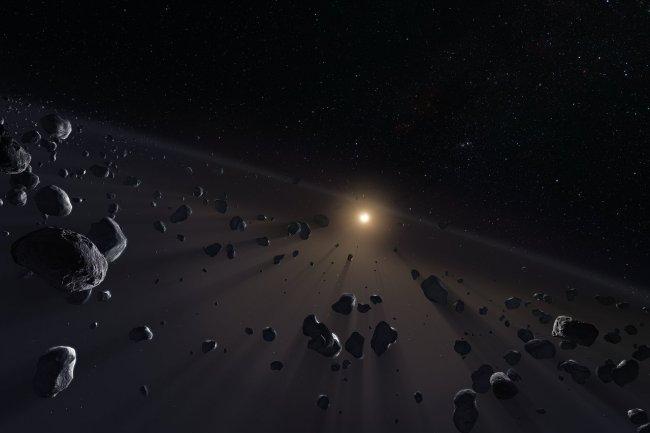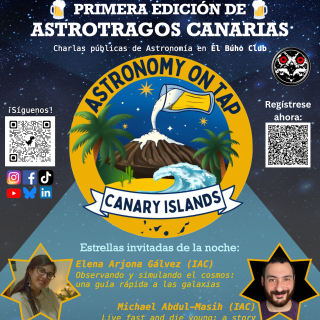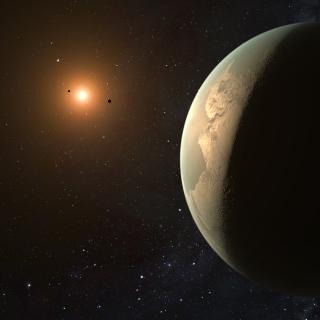Un equipo de astrónomos europeos, del que forman parte investigadores del Instituto de Astrofísica de Canarias (IAC), ha usado datos recopilados por el telescopio de rastreo VISTA (Visible and Infrared Survey Telescope for Astronomy), del Observatorio Europeo Austral (ESO), para obtener datos de una diversa población de pequeños cuerpos del Sistema Solar en el rango del infrarrojo cercano. Con ello consiguieron catalogar cerca de 40.000 objetos que podrían ayudar a responder preguntas clave sobre los inicios del Sistema Solar.
A team of European astronomers with members from the Instituto de Astrofísica de Canarias (IAC) has used data taken by VISTA, the Visible and Infrared Survey Telescope for Astronomy of the European Southern Observatory to obtain information about a diverse population of small bodies in the Solar System using near infrared measurements. Using these data, they have catalogued around 40,000 objects which could help to answer key questions about the earliest phases of the Solar System.
Se sabe que el Sistema Solar está compuesto de millones de pequeños cuerpos de los cuales se conocen las órbitas de unos 700.000, que abarcan desde asteroides rocosos hasta cometas formados por partículas de hielo. Mediante su estudio, los astrónomos esperan comprender cómo se formó y evolucionó el Sistema Solar, además de reunir información acerca de posibles impactos en la Tierra.
We know that in the Solar System there are millions of small bodies, of which we know the orbits of around 700,000 which range from rocky asteroids to comets formed from ice particles. By studying them, astronomers hope to understand how the Solar System formed and evolved, as well as collecting information about their possible impacts on the Earth.
Ahora, por primera vez, se han analizado los datos del sondeo, revelando información sobre una amplia muestra de pequeños cuerpos del Sistema Solar. El equipo examinó un subconjunto del sondeo VISTA Hemisphere Survey, que comprendía alrededor del 40% del hemisferio sur del cielo, y fueron capaces de extraer la posición y el brillo de casi 40.000 objetos, además de información del color de alrededor de 35.000, que es útil para conocer la composición de su superficie y clasificarlos.
Now, for the first time, the survey data have been analyzed, yielding information about a big sample of small Solar System bodies. The team examined a subset of the VISTA Hemisphere Survey, which covered some 40% of the southern hemisphere of the sky, extracted the positions and magnitudes of almost 40,000 objects, as well as information about the colours of 35,000 of them, which is valuable to find the surface composition and to classify them.
Javier Licandro, investigador del IAC y uno de los autores del estudio, explica que también aporta información sobre familias colisionales de asteroides, es decir, grupos de asteroides que se forman por la colisión de un asteroide con otro más pequeño. El estudio permite, igualmente, determinar la fracción de objetos que, pareciendo estar en esa familia por sus características orbitales, no son trozos del asteroide "padre", sino que son asteroides que no guardan relación alguna con la familia. “Con este catálogo –añade Licandro- se puede incluso identificar asteroides "raros", objetos con una composición superficial diferente e inusual, en diferentes lugares del cinturón de asteroides. Es el caso de los asteroides basálticos tipo V, objetos de composición superficial similar a Vesta, el segundo objeto con más masa del cinturón de asteroides del Sistema Solar. Estos asteroides están compuestos de materiales que provienen de la actividad volcánica del objeto precursor y cuya identificación permite estudiar la formación de otros asteroides similares a Vesta en una etapa muy temprana del Sistema Solar y que se han destruido por colisiones, quedando dispersos en él restos de esos eventos catastróficos.”
Javier Licandro, a researcher at the IAC and one of the authors of the study, explained that it also gives information about the collisional families of asteroids, i.e. groups of asteroids which are formed by the collision of an asteroid with a smaller one. The study also allows us to determine the fraction of the objects which appear to be part of a family when considering their orbital elements, but are not pieces of the “father” asteroid, rather they are asteroids not related to the family. “Using this catalogue”, adds Licandro, “we can also identify rare objects, with surface compositions which are different and unusual, in various places in the asteroid belt. This is the case for basaltic asteroids of type V, objects with a surface composition similar to that of Vesta, the second most massive object in the asteroid belt of the Solar System. These asteroids are made of material which comes from the volcanic activity of their precursor object, and whose identification allows us to study the formation of other asteroids similar to Vesta in a very early phase of the Solar System, and which have been destroyed by collision, which scatter the remains of these catastrophic events”.
La variada "fauna" identificada en el catálogo incluye ejemplos de todas las categorías de objetos de este tipo conocidos: asteroides cercanos a la Tierra, Mars Crossers –asteroides que cruzan la órbita de Marte-, asteroides Hungaria, asteroides del Cinturón Principal, asteroides Cibeles, asteroides Hilda, Troyanos, cometas y objetos del cinturón de Kuiper entre otros.
The varied “fauna” of this catalogue include examples of all the categories of the objects known as Near Earth Objects, Mars Crossers- asteroids which cross the orbit of Mars, Hungaria asteroids, asteroids of the main belt, Cibeles asteroids, Hilda asteroids, Trojans, comets and Kuiper belt objects, among others.
VISTA es el telescopio de rastreo más grande del mundo y cuenta con un espejo de 4,1 m de diámetro. Con su amplio campo de visión y sus sensibles detectores, proporciona a los astrónomos una visión completamente nueva del cielo austral. Los sondeos del cielo son una poderosa herramienta de estos grandes y sensibles detectores en la actualidad ya que permiten catalogar rápidamente un gran número de objetos celestes y realizar análisis estadísticos de ellos. Son ideales para aquellos astrónomos que buscan, como en este caso, objetos cercanos en movimiento como asteroides y cometas.
Vista is the largest survey telescope in the world, and has a mirror of 4.1m diameter. With its large field of view, and sensitive detectors, it gives astronomers a completely new view of the southern sky. Sky surveys are powerful tools offered by these sensitive detectors nowadays, because they allow us to catalogue rapidly a large number of objects in the sky, and to perform statistical analyses of them. They are also ideal for those astronomers who, as in this case, are looking for nearby moving objects, such as asteroids and comets.
Article: “Near-infrared colors of minor planets recovered from VISTA - VHS survey (MOVIS)” by M. Popescu (IMCCE e Astronomical Institute of the Romanian Academy), J. Licandro (IAC-ULL), D. Morate (IAC-ULL), J. de León (IAC-ULL), R. Rebolo (IAC-ULL), D. A. Nedelcu (IMCCE e Astronomical Institute of the Romanian Academy), R. G. McMahon (Astronomy Institute of Cambridge University and Klavi Institute of Comoslogy of the Cambridge University), E. Gonzalez-Solares y M. Irwin (Astronomy Institute of Cambridge University). Astronomy & Astrophysics, 591, A115. DOI: http://dx.doi.org/10.1051/0004-6361/201628163
http://www.aanda.org/articles/aa/pdf/2016/07/aa28163-16.pdf
Contact: Javier Licandro (IAC): jlicandr [at] iac.es (jlicandr[at]iac[dot]es)
- ESO press release: http://www.eso.org/public/spain/announcements/ann16042/?



